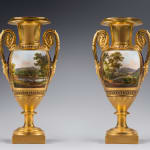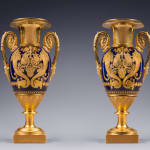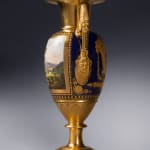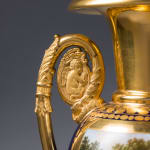Nast Frères Manufactory (attributed to)
Further images
An extremely fine and high quality pair of Restauration gilt and polychrome painted Paris Porcelain two-handled vases probably by Nast Frères Manufactory, each of baluster form with a gilded rim above scrolled acanthus-wrapped handles, each enclosing at the top a winged putto holding a quiver of arrows and terminated by a mask head, the bodies decorated at the front with framed Continental views each with trees in the foreground, one showing rustic figures and horses in front of a river on which floats a barge approaching a wooden bridge and on the far bank buildings below an Italianate fortified town, the other scene showing three figures in the foreground on a wooded hill with a riverside town and mountains beyond, the reverse of each vase with elaborate gilt arabesque decorations upon a dark blue ground to include a pair of swans above a bearded mask head flanked by bountiful cornucopia, fruiting vine trails and foliate scrolls, each of the lower bodies of the vase painted with gilt grisaille leaves upon a spreading circular foot and fluted squared base
Paris, date circa 1820
Height 55 cm. each.
Whilst this pair of vases bare close comparison with examples made by the Sèvres Porcelain Factory, the lack of the Sèvres mark makes it impossible to ascribe them to the latter. Rather they should be described under the collective term of 'Paris Porcelain' that included about 37 factories appearing in and around the capital during the late eighteenth and early nineteenth centuries. Due to the number of different factories and often lack of markings it is generally impossible to distinguish the names of the different makers. However based on their exceptional quality as well as their individual style, it is very likely that they were made by Nast Frères. In particular they compare with a pair of vases of circa 1820 by the same firm in the Musée du Louvre, Paris which are of the same amphorae form as here; likewise they are decorated on the fronts with similar intricately painted Continental landscape above identical foliate bands but have winged figural handles and a dark red rather than blue ground. The model for the pair of vases in the Louvre was introduced by Nast at the 1819 Exposition des Produits des Manufactures and illustrated in the 'Annales de l'Industrie' at which date the vases were white with decoration painted in relief. When the Nast Manufactory again exhibited the same type of vase at the 1823 exhibition, King Louis XVIII purchased a pair decorated with Italian views, of which one showed Lake Trasimeno. Like the latter pair, the present landscape views were almost certainly inspired by Italianate paintings of Jean-Victor Bertin (1767-1842) and engraved by Charles Ransonnette in circa 1800-2.
The Nast Manufactory was founded by Jean Népomucène Hermann Nast (1754-1817) who, born in Austria, worked at as a porcelain manufacturer in Versailles before acquiring his own factory in Paris in 1783. Following its successes through sales to the French Directory and the court of Napoleon I, Nast opened a much larger Paris factory in 1806. There Nast, aided by his two sons Henri and François, introduced new techniques for the application of gold porcelain in high bas-relief which he patented in 1810. The manufactory was also in the forefront of developing new strong coloured glazes, for instance working with French chemist Louis Vauquelin, Nast created an intense malachite green glaze called viridian that was able to remain stable at very high temperatures.
The firm's products were sold to the cream of French society, European royalty as well as President James Madison of America. Following the death of Nast in 1817, the factory was successfully continued by his sons who won many clientele and gained significant approval, not least from King Louis XVIII, who when visiting an exhibit of the firm's wares at the Louvre during the Paris Expostition of 1819, praised Henri and François Nast, noting "I observe with great pleasure the talent passed from father to son, I urge you to cultivate this."
The present pair of vases, like those by Nast Frères in the Louvre represents a technical feat since they are made exclusively of porcelain - even the handles, which appear to be made of bronze. The fact that Nast Frères declined to use gilt bronze caused much concern for Alexandre Brongniart, the director of Sèvres since his workshops were still unable to produce vases of such size without the addition of gilt bronze mounts. Moreover, Brongniart was piqued to see King Louis XVIII purchase these types of vases from Nast Frères, since he considered that the king should solely support the establishments of which he was the protector. Nevertheless Louis XVIII continued to be 'disloyal' to the Royal Manufactory.







